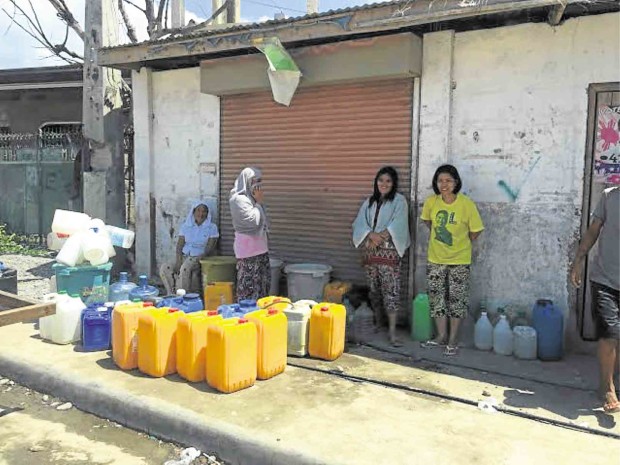
RESIDENTS of Barangay Rio Hondo in Zamboanga City await their rationed supply of water as the intense heat dries up water sources in the city. JULIE S. ALIPALA / Inquirer Mindanao
ZAMBOANGA CITY—Vegetable farmer Annaliza Pabayos, 41, had to dip into her savings for the purchase of seeds and farm inputs for the next cropping season in order to buy food.
Pabayos, a resident of Barangay San Roque here, said she had no choice if she did not want her family to starve.
They also had to buy water, which had become expensive because of the long drought that dried up many water sources.
Pabayos said there was nothing to harvest from her vegetable farm, as the crops died last month. “The vegetables did not survive the extreme heat,” she said.
Now, the farm is overgrown with weeds.
To meet the family’s daily needs, Pabayos tends a small sari-sari store in the village.
In Aurora town in Zamboanga del Sur province, the situation is not much better for Mateo Anlap, a 63-year-old rice farmer.
His rice field is now a wasteland, Anlap said. “I can’t even collect leaves to feed the pig.”
Anlap sold all of his 200 ducks and some farm animals so the family would have some money to spend and to throw a thanksgiving party for his graduating son.
Browned grass
Though he still has a few farm animals left, Anlap said he was not sure they would survive if the drought continued. “Even grasses had turned brown and gray,” he said.
Pabayos and Anlap are among almost 10,000 farmers in Western Mindanao who bear the brunt of the protracted drought. The number is still growing, Ray Anthony Credo, El Niño focal person of the Department of Agriculture (DA) in the region, told the Inquirer.
Western Mindanao consists of the provinces of Zamboanga Sibugay, Zamboanga del Sur and Zamboanga del Norte, and the cities of Pagadian and Zamboanga.
As of April 5, the long dry spell attributed to the weather phenomenon known as El Niño had already damaged 12,881.80 hectares of farms planted to rice, corn and other high-value crops in the region. Income lost so far had been placed at P466.334 million.
Hardest hit was Zamboanga del Sur with P182 million in crop losses, followed by Zamboanga Sibugay with P177.4 million. Zamboanga del Norte lost P83 million and this city suffered P24 million in damage.
But Credo said starvation did not seem to be a problem as yet. “We haven’t received reports of farmers going hungry or demanding rice like what happened in Kidapawan City,” he said, referring to the five-day protest in North Cotabato that resulted in the death of three people.
If farmers in Western Mindanao got hungry, Credo said, the National Food Authority in the region could immediately provide assistance. “The National Food Authority is mandated to set aside a certain number of bags [to help farmers],” he said.
Rice is available if farmers ask for it, Credo said, adding that his agency had instituted mitigating measures to prevent incidents like what happened in Kidapawan.
In Zamboanga City, officials said they would not wait for farmers to demand rice subsidy. The City Disaster Risk Reduction and Management Council, chaired by Mayor Maria Isabelle Salazar, has approved a resolution for the distribution of rice to affected communities, according to city agriculturist Diosdado Palacat.
Each farming household affected by the drought has been allocated 25 kilograms of rice.
The city social welfare office, Palacat said, would also provide cash-for-work opportunities.
Credo acknowledged that assistance to farmers in the region, particularly for planting and irrigation for the next cropping season, was delayed.
“Much as we want to give aid, the funds are still stalled at the Department of Budget and Management (DBM). Without these funds, we cannot immediately help our farmers if they start planting or if the rains come,” he said.
Waiting for funds
The DA regional office plans to acquire more than 16,000 bags of certified rice seeds and an equal number of bags of corn seeds for distribution, as well as to distribute materials for construction of shallow tube wells, Credo said.
Money for these programs has not yet been released. Credo said the agency was hoping that the DBM would release the El Niño mitigating funds before May.
“We need this before May. May is usually the start of the rainy season and seeds have to be distributed,” Credo said.